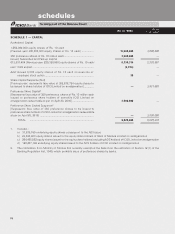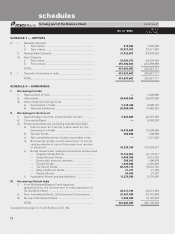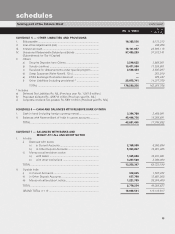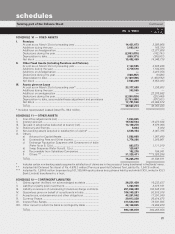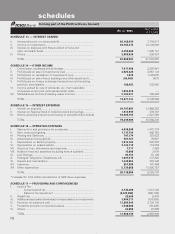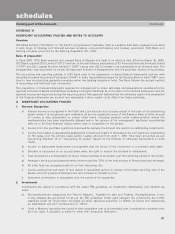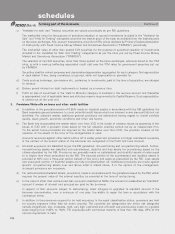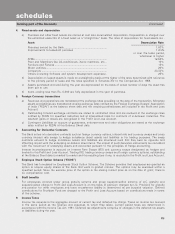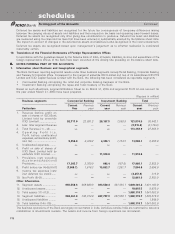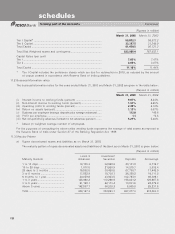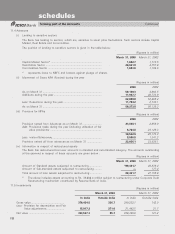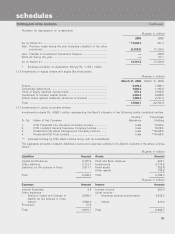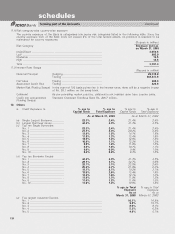ICICI Bank 2003 Annual Report Download - page 78
Download and view the complete annual report
Please find page 78 of the 2003 ICICI Bank annual report below. You can navigate through the pages in the report by either clicking on the pages listed below, or by using the keyword search tool below to find specific information within the annual report.
F14
forming part of the Accounts Continued
schedules
c) ‘Available for sale’ and ‘Trading’ securities are valued periodically as per RBI guidelines.
The market/fair value for the purpose of periodical valuation of quoted investments included in the “Available for
Sale” and “Held for Trading” categories would be the market price of the scrip as available from the trades/quotes
on the stock exchanges, SGL account transactions, price list of RBI, prices declared by Primary Dealers Association
of India jointly with Fixed Income Money Market and Derivatives Association (“FIMMDA”) periodically.
The market/fair value of other than quoted SLR securities for the purpose of periodical valuation of investments
included in the ‘Available for Sale’ and ‘Trading’ categories is as per the rates put out by Fixed Income Money
Market and Derivatives Association (“FIMMDA”).
The valuation of non-SLR securities, other than those quoted on the stock exchanges, wherever linked to the YTM
rates, is with a mark-up (reflecting associated credit risk) over the YTM rates for government securities put out
by FIMMDA.
Securities shall be valued scripwise and depreciation/appreciation aggregated for each category. Net appreciation
in each basket if any, being unrealised, is ignored, while net depreciation is provided for.
d) Costs such as brokerage, commission etc., pertaining to investments, paid at the time of acquisition, are charged
to revenue.
e) Broken period interest on debt instruments is treated as a revenue item.
f) Profit on sale of investment in the ‘Held to Maturity’ category is credited to the revenue account and thereafter
is appropriated, (net of applicable taxes and statutory reserve requirements) to Capital Reserve. Such appropriation
is carried out at the year end.
3. Provisions/Write-offs on loans and other credit facilities
a) In addition to the general provision of 0.25% made on standard assets in accordance with the RBI guidelines the
Bank maintains general provisions to cover potential credit losses which are inherent in any loan portfolio but not
identified. For standard assets, additional general provisions are determined having regard to overall portfolio
quality, asset growth, economic conditions and other risk factors.
b) The Bank has incorporated the assets taken over from ICICI in its books at carrying values as appearing in the
books of ICICI with a provision made based on the fair valuation exercise carried out by an independent firm.
To the extent future provisions are required on the assets taken over from ICICI, the provision created on fair
valuation of the assets at the time of the amalgamation is used.
Amounts recovered against other debts written off in earlier years and provisions no longer considered necessary
in the context of the current status of the borrower are recognised in the Profit and Loss Account.
c) All credit exposures are classified as per the RBI guidelines, into performing and non-performing assets. Further,
non-performing assets are classified into sub-standard, doubtful and loss assets for provisioning based on the
criteria stipulated by the RBI. Provisions are generally made on substandard and doubtful assets at rates equal
to or higher than those prescribed by the RBI. The secured portion of the sub-standard and doubtful assets is
provided at 50% over a three-year period instead of five and a half years as prescribed by the RBI. Loss assets
and unsecured portion of doubtful assets are fully provided/written off. Additional provisions are made against
specific non-performing assets over and above what is stated above, if in the opinion of the management,
increased provisions are necessary.
d) For restructured/rescheduled assets, provision is made in accordance with the guidelines issued by the RBI, which
requires the present value of the interest sacrifice be provided at the time of restructuring.
e) In the case of other than restructured loan accounts classified as NPAs, the account is reclassified as “standard”
account if arrears of interest and principal are paid by the borrower.
In respect of loan accounts subject to restructuring, asset category is upgraded to standard account if the
borrower demonstrates, over a minimum of one year, the ability to repay the loan in accordance with the
contractual terms.
f) In addition to the provisions required to be held according to the asset classification status, provisions are held
for country exposure (other than for home country). The countries are categorised into seven risk categories
namely insignificant, low, moderate, high, very high, restricted and off-credit and provisioning made on a graded
scale ranging from 0.25% to 100%. For exposures with contractual maturity of less than 180 days, 25% of the
normal requirement is held.




